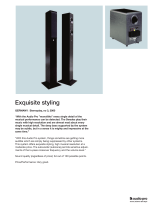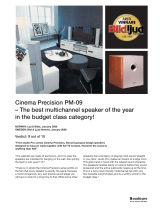
21 22
Charlie Bolton
I’ve been a product designer for over ten years, seven of those
years at Philips. I have designed many products for Philips:
headphones, TVs and speakers. I moved to the Hong Kong Design
Studio in 2007 where I am the lead designer for the Fidelio speaker
range. This has been one of the highlights of my career so far -
I worked on the original Fidelio speaker family, and I have seen
it grow to the point where we are now market leaders in this
category.
My role as Senior Design Consultant has a wide variety of
responsibilities. The most enjoyable part is the actual designing: the
early stage in the project where you have to think of new ideas
and create new concepts. However, that is just one part of my job.
As important as coming up with the design is making sure it gets
to market. Therefore co-designing with acoustic and mechanical
engineers is essential in achieving a winning proposition.
In the design studio I am surrounded by inspiring material.
Our visual trends team has a complete library of every imaginable
material. As well as this, my design colleagues always have their
latest ideas and projects on display, so just working around the
studio you can get inspired by other peoples work. For the Fidelio
docking range we have started looking at using natural materials
that enhance acoustic performance. For the rst time we used real
wood housings instead of plastic.
Michael Paterson
During the past ve years I have been involved in the industrial
design of many audio products from 5.1 home cinema, to
SoundBars and more recently the Shoqbox portable wireless
speaker range.
What I love about designing audio products is the challenge.
The key to the process is balancing the technical aspects of
acoustics and the creative nature of design. To produce a
distinctive and desirable product that works beautifully and does
not compromise on performance. Understanding how to balance
these is the key to creating relevant design and excellent audio
products.
The reward of being a designer is that you are able to reach
and inuence many people through your creative work. To be at
the core of bringing products to life, that people use and enjoy
every day. Seeing the products I’ve designed in store or seeing
someone use it and hearing what they think still excites me.
For me this validates what I do.
What has most affected the design of audio products in recent
years is that people want their audio products to sound better
and better, the expectation of sound quality continually increases.
When you go to the movies, it’s because you want to get
swept away for a moment. You want to get totally lost in what’s
happening on-screen - and around you. Sound plays a massive
part in that experience. Our job is to perfectly recreate that
authentic movie experience in your home and ensure that our
design is the visual synthesis of that authentic experience. It has
to work beautifully and the look and feel must testify to the
excellent acoustic capabilities of the product.
Wai Chung
Philips was my rst employer and I’m still here now, so essentially
this is my rst job! I have been in design for sixteen years and I’ve
been involved in audio since 2002. This started with headphones,
then I moved into personal audio, and now my role is Senior
Design Consultant in the home audio team working with a group
of designers on products such as Hi-Fis, clocks and boom-boxes.
In basic terms I am product designer - one that helps with the
whole process of product development from concept to nal
design. This starts with the initial sketch workshops, the discussions
with the engineers regarding technical restraints, nalizing the
design, the production of the rst molded parts, down to the trial
runs until the product is realized.
It is an exciting time for us developing the Fidelio range. We have
a clear vision of what we want to achieve and by working with
the acoustic engineers from the early stages, we are very proud to
be able to craft a selection of premium products that have great
sound, are well integrated and have really well considered features.
It is a very inspiring range in terms of design.
Bazil Tung
I’ve always been very hands-on since I was young, and I get
immense gratication out of making things with my hands.
Whether it is making objects or making music, there is always a
natural urge to create. Over the years, this love of making grew
into an appreciation in well designed objects and admiration for
well produced sound. Soon, passion turned into an obsession,
and it became clear that audio design was the best possible
outlet for both of these passions to live out.
The great thing about my role being an audio designer at Philips,
is that I get to be very hands-on in the entire development
process from start to the nish – dening and drawing out
product concepts, prototyping acoustic and wearing comfort
ideas, and following through to manufacturing executions before
the piece is nally completed and arrived on the shop shelves.
And every day can be quite different. We can be throwing
innovative product ideas around the room one day, making
decisions on colors and nishing with the trends team the next,
and in between we challenge our acoustic experts and suppliers
on how to achieve the perfect sound and bring all of our ideas
to reality – what is typical about design at Philips is that there is
never a typical day, there is never a dull moment.
To work in audio design at Philips, you have to be equally
passionate about making great designs and great sound, be
engaged in what you create and genuinely care about reaching
people. I think only this kind of obsession inspires creativity,
and in turn making truly great and meaningful audio products.
Design consultants




























